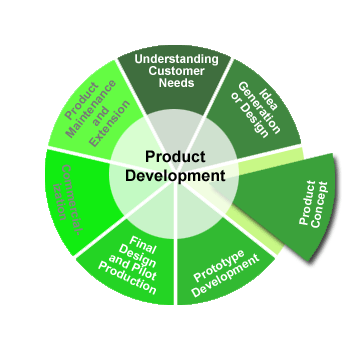

|
Design and Product Development |
Copyright 2006
Cornell
University.
All rights reserved.
|
In the product concept stage, ask several crucial questions to identify the value proposition of your product.
Adding value to your product 1. New product development process innovation by addressing a need, introducing new materials, design features, brand name value, workmanship, packaging, quality. This is the value proposition that most often comes to mind in entrepreneurship- being the first to offer an innovative product. It's always advisable to do thorough research on the market offerings and on whether consumers will like your product. A business based on this value proposition needs to know and be different from its competition. Customers should be able to describe the special features of the product that makes them buy it instead of another. Innovation should be added throughout the product's life cycle. 2. Inventory management process lowers inventory or raw materials and finished goods A company that can lower its inventory holdings and still offer a product in a timely manner has value based on reducing costs. A good example is a custom-made dress that is made to order with only enough fabric and trimmings purchased for the orders. Buying materials and producing goods "just in time" to fill the orders is another example. Technology and computer software is available to help you plan and organize your production to reduce inventory costs of materials and finished goods. 3. Order-to-delivery-to-payment process - reduces the time and efficiency of taking orders, producing goods, and delivering. Streamlining the order-to-delivery-to-payment process can add value to a product. Some businesses offer products similar to others in the marketplace, but offer shorter lead time for production and faster delivery methods. Information technology is again the key. It offers efficient communications with customers and business partners that speeds up the production and delivery process. As off-shore and domestic options for apparel production increase, time may make the difference in the decision to buy from one business rather than another.
4. Customer service process builds an effective communication process with customers during initial inquiries, order and delivery, and post-purchase questions. Electronic communication, technical manuals, and repair and maintenance agreements can aid customer service. From easy shopping and ordering processes to life-time guarantees of products and generous exchange policies, customer service can be a successful business value proposition. Either by itself or in combination with another value proposition, customer service is increasingly used to differentiate product offerings.
Relating product value and business objectives
According to one estimate, out of 64 ideas that a major business might start with, only 2 will make it to a national launch. (See the chart below.) Moreover, the cost to test, develop, market, and launch a new product grows exponentially at each stage from idea to launch.
Small businesses and entrepreneurs will concentrate on local or niche markets rather than a national launch. Still, every businesses of any size should recognize that every idea will not make it to market.
|
||||||||||||||||||||||||||||||||||||||||
 Product concept: adding value to your product
Product concept: adding value to your product


